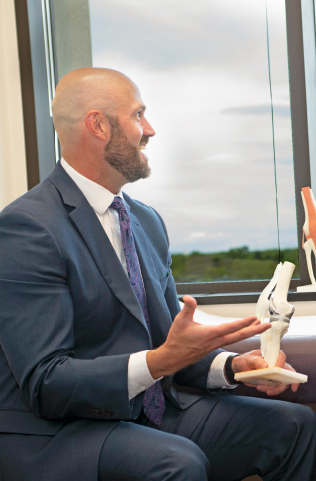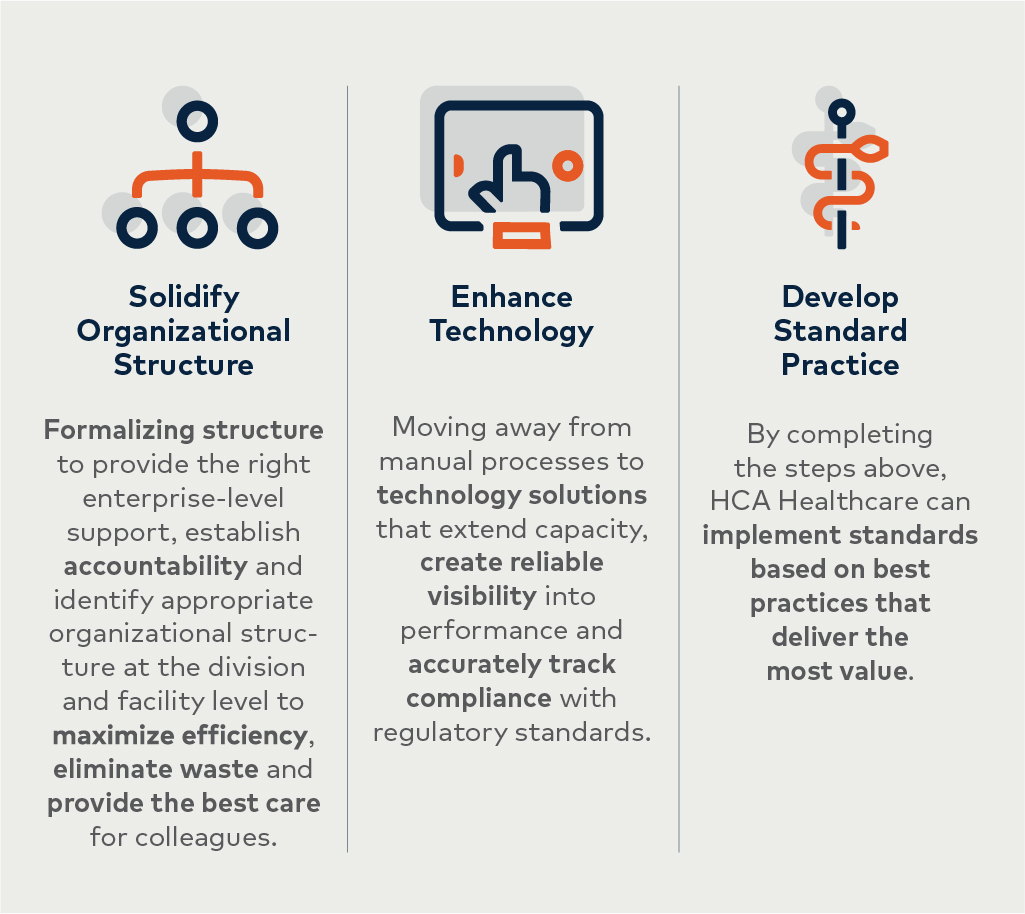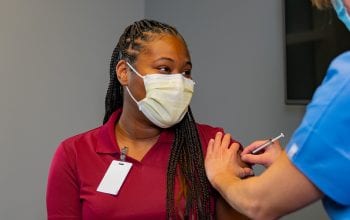Investments in patient safety and innovative care delivery are transforming the way patients experience our services.


The art of medicine, by nature, includes the never-ending search for better outcomes. At HCA Healthcare, our facilities perform well above the national averages, according to The Leapfrog Group, a patient advocacy firm. In fall 2022, 81% of HCA Healthcare facilities were recognized with an “A” or “B” hospital safety grade, a figure 24% higher than the national average of 57%. These grades reflect how well hospitals protect patients from preventable medical errors, accidents, injuries and infections.
Still, we strive to perform even better.
In mid-December 2020, HCA Healthcare adopted an Enhanced Surgical Recovery (ESR) program, a patient-centered, research-based, multidisciplinary approach to surgical recovery. Implemented in 167
HCA Healthcare facilities, it’s already demonstrated significant improvements in surgical recovery. Notable among those improvements are reducing the length of hospital stays by an average of two days and decreasing opioid usage by up to 44% for some surgeries.
“After studying more than 20 years of clinical research and peer-reviewed publications in addition to our own internal data, we discovered that a facility making a few key changes, such as using multimodal approaches to managing pain and encouraging patients to eat and walk around within 24 hours after surgery, can have a significant impact on a patient’s recovery,” says Randy Fagin, MD, chief medical officer of HCA Healthcare’s National Group. “From the physician’s office prior to surgery to follow-up care, a facility’s ESR program allows patients to play an active role in managing their own care and recovery plan.”
From the physician’s office prior to surgery to follow-up care, a facility’s ESR program allows patients to play an active role in managing their own care and recovery plan.— Randy Fagin, MD, chief medical officer of HCA Healthcare’s National Group
Building on Past Success
The ESR program derived from Enhanced Recovery after Surgery (ERAS), an existing recovery program that’s been standard practice in Europe for a number of years and consists of up to 21 surgery-related components. Publications on the positive impact of ERAS led to a collaboration between the Clinical Services Group and HCA Healthcare research colleagues, who studied the relative impact of each element. Their findings resulted in “our focusing on a more limited set of key tactical elements that included multimodal pain management, goal-directed fluid therapy, pre-surgical carbohydrate-load and early ambulating,” says Kristy Frazier, MBA, BSN, RN, CSSM, assistant vice president of Surgical Services for
HCA Healthcare.
In 2016, the focus was on total joint replacement procedures, followed by colorectal and major abdominal cases. By 2021, the protocol became a standard of care across all surgical cases. HCA Healthcare’s ESR program focuses on the six tactics believed to have the greatest impact on patient outcomes:
- Goal-directed fluid therapy. Active monitoring of a patient’s fluid balance to achieve optimal hydration level throughout surgery.
- Patient education. Providing patients with a personal recovery checklist so they can take an active role in their care.
- Multimodal pain management. An individualized approach using opioids only on an as-needed basis, substituting non-opioid pain relievers and other pain management techniques.
- Permissive preop hydration/carb loading. Drinking fluids and a carbohydrate-rich drink before surgery to improve hydration and insulin resistance and curb nausea.
- DREAM = DRinking, Eating And Mobilization within 24 hours postop. Encouraging patients to drink, eat and move shortly after surgery.
- Multidisciplinary team. Creating a group of team champions — including colleagues from surgery, anesthesia, nursing and pharmacy — collaborating to guide the facility’s program and each patient’s care journey.

HCA Healthcare’s 182 hospitals and 126 surgery centers are collaborating with specialized physicians to provide high-quality, personalized care for those recovering from surgery.
“The program is aimed at minimizing the physiologic impact of surgery in the immediate recovery period,” says Laura Williams, MD, GYN Oncology with the Physician Services Group. “Tactics like multimodal pain control minimize opioid use, which has a profound impact on improving how quickly a patient can return to normal functions like eating, drinking and mobilizing.”
According to Dr. Fagin, nearly 1 million patients in 2022 benefited from HCA Healthcare’s use of ESR as a part of our normal surgical care pathway. To better understand how the ESR program works, think of patients as athletes training for a race.
“It’s important to ensure every patient is in the best medical shape before surgery, and that we work to optimize their body’s performance throughout their surgical experience,” says Kristy.
A carbohydrate-rich drink consumed before surgery helps maintain whole-body protein balance and muscle function. Patients receive their first scheduled dose of a multimodal pain regimen before surgery helping to reduce their discomfort afterward.
During surgery, the anesthesia provider monitors the patient’s fluids to ensure proper perfusion. Maintaining an optimal fluid balance during surgery can reduce postoperative complications.
“Most patients receive regional or epidural anesthesia for surgery in addition to multimodal pain medications to reduce the pain they experience after the procedure,” says Kristy.
Another program component avoids using tubes, lines or drains during surgery, which can minimize postop infections and complications. Nausea and vomiting can also occur after surgery, so administering medications during surgery can lower the likelihood of these unwanted side effects.
After surgery, and often while they’re still in the recovery room, patients begin to eat, drink and ambulate while continuing their multimodal pain medication schedule to reduce the need for opiates.
“By controlling pain while lowering the need for opiates, which can cause drowsiness, nausea and poor coordination, ESR improves how quickly a patient can return to basic activities,” says Dr. Williams. “And the sooner the patient can get back to basic activities the sooner they can be safely discharged home.”
Patient-Caregiver Connection
HCA Healthcare also recognizes a direct correlation between patient and colleague health and safety.
Ryan Sledge, MBA, MPH, vice president of our Workforce Health and Safety division, came to HCA Healthcare tasked with improving overall colleague health and welfare.
“When we think about safety — and patient safety is obviously always going to be at the forefront for any healthcare system, or should be — there is a strong link between colleague safety and patient safety,” says Ryan. “We want our colleagues to thrive so they can take better care of our patients.”
COVID-19, says Ryan, “started the conversation around how important it is to take care of ourselves in the healthcare environment.” Long shifts without breaks can lead to mental and physical fatigue.
Ryan points to the litany of health issues, including stress-related burnout, which helped fuel a “great resignation” throughout healthcare. The exodus of medical professionals is recognized as a major patient safety risk because there’s a strain on patient care without appropriate staffing.
Patient care can be improved by resolving some of the challenges that lead to burnout, Ryan says.
“We can help mitigate the folks’ leaving, the staffing challenge, which then trickles down to the impact on patient safety. It’s all connected.”
About 45 facilities have implemented a three-pronged end-to-end solution for colleague health called Enterprise Health, which will expand throughout the enterprise.
The Enterprise Health process covers almost every stop along the employment timeline, from hiring to additional educational opportunities to creating a safer work environment. It was a massive undertaking, given the sheer scope of the enterprise.
“The major challenge across the board is that we have 182 hospitals and 1,400 physician practices. We’ve got all these different spaces,” says Ryan. “There was no standardization. {Each facility} had various ways of trying to take care of their colleagues. That just led to a whole host of opportunities.”
When we think about safety — and patient safety is obviously always going to be at the forefront for any healthcare system, or should be — there is a strong link between colleague safety and patient safety.— Ryan Sledge, MBA, MPH, vice president, Workforce Health and Safety division.
Ryan says a team devoted just to colleague care was needed at the corporate level. From there, it could expand to the divisions and into the field. Full implementation across the enterprise is expected to take roughly two years. The program currently exists in 45 of the 185 facilities and across three of the five divisions.
Of course, any change brings the risk that some colleagues may resist a new way of doing things, and the new Workforce Health and Safety initiatives are no exception. However, Ryan says those pain points can be mitigated by making a concerted effort to work with colleagues, rather than simply installing new policies and procedures.
An advisory board with representation across the enterprise aims to ensure colleague concerns are heard and evaluated.
“They are actually a part of coming up with the changes that we’re going to implement,” he says, adding that the board representatives can champion health and safety initiatives in their local areas as well. It helps add buy-in to the changes when they are a part of the change. They even seek input from colleagues who weren’t selected for the board but want to be engaged.
“We find projects they can help us with, and being able to share their feedback is something that we’ve gotten a lot of traction from. They do feel heard,” Ryan says.
Overall, Workforce Health and Safety’s colleague-centric focus has built a trusting rapport, opened an outlet of communication, encourages everyone to share their ideas, and provide endless support.— Megan P. Rickman, RN, Employee Health supervisor at HCA Florida St. Lucie Hospital.
Employee feedback indicates the new policies and procedures have been well received.
“Overall, Workforce Health and Safety’s colleague-centric focus has built a trusting rapport, opened an outlet of communication, encourages everyone to share their ideas, and provide endless support,” says Megan P. Rickman, RN, Employee Health supervisor at HCA Florida St. Lucie Hospital. “With them, we know we aren’t alone.”
In essence, the new policies and procedures are an extension of
HCA Healthcare’s mission statement that, above all else, the enterprise is committed to the care and improvement of human life.
“What we say in Workforce Health and Safety is that the commitment to the care and improvement of human life extends to our own colleagues,” says Ryan.
It’s what drives their efforts, and his role is to ensure they stay the course.
“We really view this work as service to our patients through serving our colleagues,” he says. “This is an investment for HCA Healthcare. Building organizational structure, and investment in technology, those things aren’t free. But HCA Healthcare has placed a value on employee health and safety and realizes the return we get on the care that we deliver our patients.”



